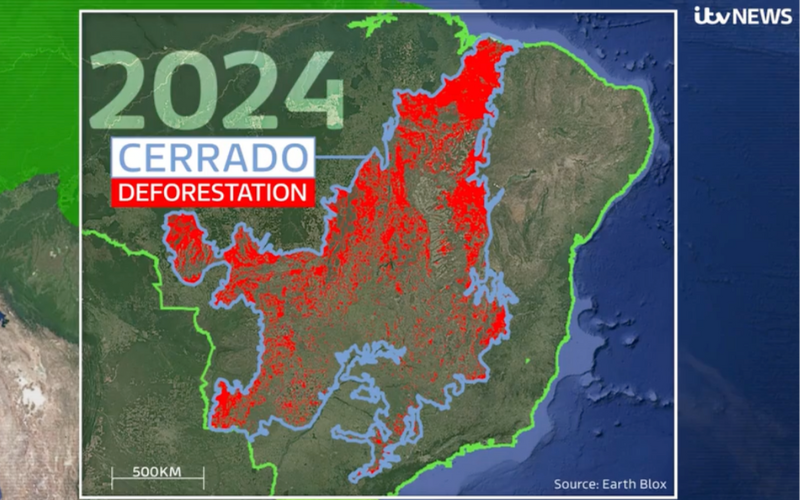Shaping the future through data: A personal journey
In the last few decades, I have dedicated my life to bringing climate and nature-positive decisions into the boardroom. Having spent 18 years as an Associate Professor at the University of Edinburgh, my research was centred on quantifying ecosystem services from big data. I was also honoured to be a contributing author to the Nobel Prize-winning IPCC Good Practice Guidance on Land Use, Land-Use Change, and Forestry (LULUC).
In 2013, I found myself urging corporate boards to take climate change seriously — not merely as an expectation but as a tangible risk requiring action. Fast forward to today, and I find myself surrounded by leaders who understand the urgency of the climate crisis. That’s why I made the leap from academia to entrepreneurship to found Earth Blox — a SaaS platform that is, essentially, a full-blown "scanner" of our planet. Earth Blox enables companies to easily assess the risks and impacts of climate and nature change, providing unique environmental insights for any location on Earth. By doing so, we empower businesses to not only become more resilient but also to drive positive change for a sustainable future.
The era of data proliferation
As we approach 2030, we find ourselves in an era not of data deficiency, but of data proliferation. The technology enablers of nature and climate are creating an explosion of data, offering us unprecedented insights into our environment. Consider the IoT systems that enable real-time impact measurements of extreme weather events, or the field surveys, eDNA, and bioacoustics that quantify biodiversity at a hyper-local level.
And that's only the tip of the iceberg. There are currently around 10,000 active satellites orbiting the Earth — a staggering tenfold increase in just a decade! A significant portion of these are used for Earth Observation. The economics of launching satellites have shifted dramatically, allowing for cost-effective deployments of larger constellations of smaller satellites, sometimes at a mere $500,000 each. These specialised missions give us data at an unparalleled scale, and two particularly notable examples are the upcoming BIOMASS mission by the European Space Agency and the NISAR mission by NASA and the Indian Space Agency. These will greatly improve global measurements of forest height, structure, and biomass — key metrics for carbon budgets and biodiversity.
There are also specialised constellations measuring methane and CO2 emissions from millions of small sources worldwide, holding sectors like fossil fuel operations and agriculture accountable. Companies like GHGSat, MethaneSAT, and Carbon Mapper are pioneering this space. At Earth Blox, we have access to such a vast amount of premium and open-access geospatial data that if we were to stack all that data onto DVDs, it would extend beyond the stratosphere. Yes, even beyond Richard Branson’s virgin galactic space rocket!
Data overload versus data insight: Finding the right fit
Despite this wealth of data, our challenge is not a lack of information. Instead, it’s about selecting the right authoritative climate and nature data for the right use case. Imagine the process of assessing a company or portfolio’s exposure to nature and climate risks. Each corporation’s supply chain and facilities must be broken down by type (e.g., office, factory, mine), and each facility’s material dependencies and impacts on nature must be assessed. To truly understand the risks, we must layer in projections of climate change, geography, and ecological shifts, combining multiple geospatial datasets.
The result? A complex, multi-dimensional matrix: thousands of industrial processes, hundreds of climate and ecosystem services, and a vast array of geographical regions and ecosystems. Without the help of emerging climate and nature tech, it would take armies of coders, consultants, and data scientists to make sense of this information — a process that’s time-consuming, costly, and convoluted.
Empowering action through technology
Thanks to advances in parallel computing, cloud storage, AI, and foundational models in Earth Observation, a new generation of technology enablers has emerged. These tools provide clarity, transparency, and auditability, allowing businesses to scale their assessments of risks, impacts, and dependencies, not just for hundreds of facilities but for millions. Imagine being able to evaluate risks from seasonal flooding, reforestation potential, climate projections, population growth, wildfires, and biodiversity loss, all at once and at scale.
Ultimately, this technology allows businesses to shift their focus. Instead of investing resources in extensive data analysis, companies can prioritise and take action — driving concrete changes on the ground that build both climate and nature-positive futures, as well as resilient supply chains.
The path to action: Beyond data and tech paralysis
So, if we have access to an immense amount of data and the technology to make sense of it, what's preventing action? I believe it boils down to a kind of "data and tech obsession." We often fall into the trap of thinking that we need better data, more advanced technology, or additional clarity on frameworks before we can act. But data and technology alone won't solve our problems — we will.
If you, like me, recognise the tangible business risks and opportunities tied to climate and nature, I urge you to act now. The data is here, the tools exist, and the time for decision-making is upon us. Let’s leverage our collective expertise to create a climate and nature-positive future, alongside resilient businesses, supply chains, and communities.
Dr. Genevieve Patenaude is the CEO of Earth Blox and an associate professor at the University of Edinburgh. She has led multiple international research projects largely focussed on the exploitation of Earth Observation and big data to solve global challenges such as poverty alleviation. Her research was funded by the UK Natural Environment Research Council, the European Union 7th Framework Programme and contributed to the Intergovernmental Panel on Climate Change’s Good Practice Guidance for Land Use, Land Use Change and Forestry.


.png)
